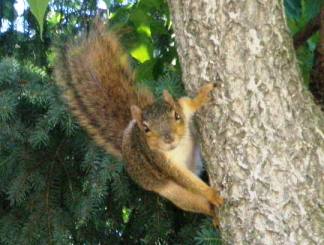Fox squirrels (Sciurus niger) are about 18 to 24 inches long including the tail. An adult weighs less than 2 pounds and has a large, bushy tail with yellow-tipped hairs. Fur is usually a grizzled rusty brown on top and buff to bright rust below but can vary from silver-gray to black. The black squirrels in Nebraska are just a genetic aberration of the common Fox squirrel.
Lifecycle
Adult fox squirrels breed during December to January and sometimes again in early summer. About 3 to 6 young are born after a 45-day gestation period. Fox squirrels do not hibernate but will increase time spent in the nest during the winter. They generally live from 4 to 7 years but can live as long as 12 years.
Tree Damage
Landowners may notice some unusual tree damage in April due to Fox squirrels stripping and ripping bark. While bark stripping typically occurs during the late winter, this damage also may occur in early spring if a spring freeze results in these squirrels losing access to smooth bark deciduous tree seeds, especially from maples and oaks.
At this time of year, the common fox squirrel buries nuts and other foods in lawns and flower beds. This behavior is instinctive, and will occur even if supplemental food is provided. In the lawn, the buried food causes little damage and spring growth of grass will repair any that does occur. In flower beds and containers, food burying can be destructive. There is no chemical repellant that keeps squirrels from digging, but chicken wire or wire mesh installed loosely over pots or beds can prevent it. Remember to remove the wire before plants start their spring growth.
Territorial Behavior
Many tree squirrels are also marking their territory. They do this by chewing on wooden objects like the base of trees, decks, picnic tables and garage doors. They may do this chewing every day for weeks in the same location. It is not for food but to leave a sign to other squirrels in the area that this territory is taken. You can stop this habit by applying a repellent to the chewed area. Commercial repellents can be effective at preventing this habit if applied on the marks and the area one foot surrounding it; remember to repeat the application often. A home-made repellent with vegetable oil and large amounts of hot pepper powders is fairly effective. Check that it doesn't stain the surface to which you hope to apply the repellent.
For more information, refer to UNL Extension's NebGuide regarding Tree Squirrels.
Preventing Damage
Preventing and limiting the scope of this damage is not easy. Landowners have only two effective options -- exclusion and/or population reduction. Exclusion is accomplished by installing plastic tree guards around tree trunks. If trees are relatively isolated, upper branches can be protected by wrapping trunks with 12-inch aluminum flashing at least three times, beginning 4 feet off the ground. Upper wraps should overlap the lower wrap by one inch. If other trees are close by, squirrels will travel using the branches, and wrap will probably not be effective.
Reduce squirrel populations by trapping or shooting. Be sure to follow all state and local laws as well as conservative safety practices. Contact the Nebraska Game and Parks Commission at (402) 471-0641, to learn of applicable laws. Be aware that the translocation of squirrels is illegal in Nebraska. If lethal control is permitted in your situation, then trapped squirrels should be euthanized. Visit the Internet Center for Wildlife Damage Management - Animal Handling, Euthanasia and Disposal.
Don't bother with repellents, ultrasound, or scare tactics. Feeding the squirrels is not advised as it will simply increase the population density in your area.


